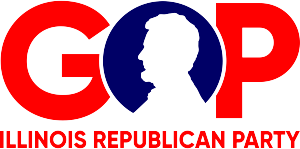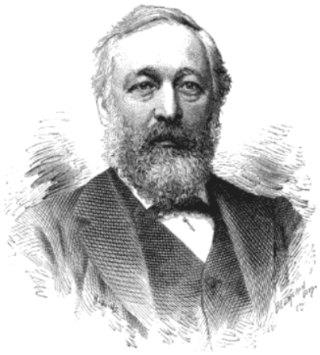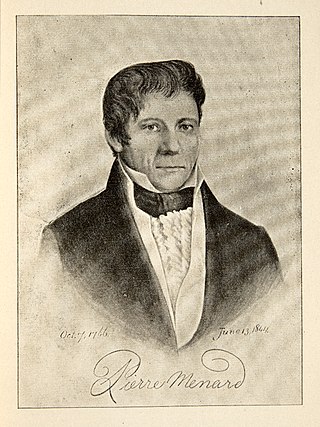
Shelby Moore Cullom was a U.S. political figure, serving in various offices, including the United States House of Representatives, the United States Senate and the 17th Governor of Illinois. He was Illinois's longest serving senator.

John Marshall Hamilton was the 18th Governor of Illinois, serving from 1883 to 1885. Born in Union County, Ohio, Hamilton became interested in politics at a young age, joining the Wide Awakes when he was thirteen and the Union Army four years later. After graduating from Ohio Wesleyan University he studied law and was admitted to the bar. A notable attorney in Bloomington, Illinois, Hamilton was elected to the Illinois Senate in 1876. He served there until 1881, when he was elected Lieutenant Governor of Illinois on a ticket with Shelby Moore Cullom. When Cullom resigned after election to the United States Senate, Hamilton became Governor of Illinois. He was not selected as a candidate for re-election, but did serve that year as a delegate to the 1884 Republican National Convention. He spent the rest of his life as an attorney in Chicago, where he died in 1905.

Lawrence Yates Sherman was a Republican politician from the State of Illinois. He served as United States Senator, the 28th Lieutenant Governor, and as Speaker of the Illinois House of Representatives.

Richard Yates Jr. was the 22nd Governor of Illinois from 1901 to 1905—the first native-born governor of the state. From 1919 to 1933, he served in the U.S. House of Representatives from Illinois.

United States gubernatorial elections were held on November 5, 2002, in 36 states and two territories. The Republicans won eight seats previously held by the Democrats, as well as the seat previously held by Minnesota governor Jesse Ventura, who was elected on the Reform Party ticket but had since renounced his party affiliation. The Democrats won 10 seats previously held by the Republicans, as well as the seat previously held by Maine governor Angus King, an independent. The elections were held concurrently with the other United States elections of 2002.

The Illinois Republican Party is the affiliate of the Republican Party in the U.S. state of Illinois founded on May 29, 1856. It is run by the Illinois Republican State Central Committee, which consists of 17 members, one representing each of the state's congressional districts. Once the dominant party in Illinois, the state GOP has become a minority party within the last few decades, holding little power in the state. The current chairman is Kathy Salvi, who has served since 2024.

The 1994 South Carolina gubernatorial election was held on November 8, 1994, to select the governor of the state of South Carolina. The contest featured two politicians from the Upstate and David Beasley narrowly defeated Nick Theodore to become the 113th governor of South Carolina.

The John M. Hamilton House is a historic house located at 502 South Clayton Street in Bloomington, Illinois. John Marshall Hamilton, who served as governor of Illinois from 1883 to 1885, lived in the house prior to becoming governor. The house was built circa 1872 by fur trader James Clark, who sold the property to Hamilton in 1873. Hamilton's state political service began while he lived in the house, as he was elected to the Illinois Senate in 1876; he served in the senate for four years and became president pro tem in 1879. In 1881, Hamilton was elected lieutenant governor under Shelby Moore Cullom; when Cullom became a U.S. Senator, Hamilton assumed the governorship. Hamilton left his house upon taking office and never returned to Bloomington.

The 1994 Idaho gubernatorial election was held on November 8 to select the governor of the U.S. state of Idaho. Democratic incumbent Cecil Andrus chose not to seek reelection after a total of fourteen years in office. Former state senator and Republican Party chair Phil Batt rallied to defeat Democratic attorney general Larry Echo Hawk; the victory was the first by a Republican in 28 years.

The 1986 Illinois gubernatorial election was held on November 4, 1986. Republican candidate James R. Thompson won a fourth term in office, defeating the Illinois Solidarity Party nominee, former United States Senator Adlai Stevenson III, by around 400,000 votes.

The 1856 Illinois gubernatorial election was the eleventh election for this office. Democratic governor Joel Aldrich Matteson did not seek re-election. Former Democratic Congressman William Henry Bissell was nominated by the newly formed Republican Party at the Bloomington Convention. Former Whig Mayor of Chicago Buckner S. Morris was nominated on the Know-Nothing Party ticket.

The 1990 Illinois gubernatorial election was held on November 6, 1990 to elect the governor and lieutenant governor of Illinois. The incumbent Governor Jim Thompson chose to retire instead of seeking reelection to a fifth term. The Republican nominee, Secretary of State Jim Edgar, narrowly defeated the Democratic nominee, Attorney General Neil Hartigan, by about 80,000 votes out of the over 3.2 million cast.

Andrew Shuman was an American newspaper editor and politician. A native of New York, Shuman worked at several small local newspapers until he secured a position at the Syracuse Journal in 1853. He left the position in 1856 to work as an assistant editor for the Chicago Evening Journal, a predecessor of the Chicago Sun-Times. He was elected the 21st Lieutenant Governor of Illinois in 1876. A leading candidate for the Illinois governorship in 1880, Shuman instead decided to increase his role at the Evening Journal and retired from politics.

Two United States Senate elections were held in Illinois on March 26, 1913. The two elections were interconnected through a compromise made to elect a Democrat in the regular election and a Republican in the special election.

Elections were held in Illinois on Tuesday, November 2, 1976.

Elections were held in Illinois on Tuesday, November 2, 1948.

Elections were held in Illinois on Tuesday, November 5, 1940.

The 1880 Illinois gubernatorial election was held on November 2, 1880.

The 1818 Illinois lieutenant gubernatorial election was held on 17 September 1818 in order to elect the first lieutenant governor of Illinois upon Illinois acquiring statehood on 3 December 1818. Democratic-Republican candidate Pierre Menard defeated fellow Democratic-Republican candidates William L. Reynolds and Edward N. Cullom.



















